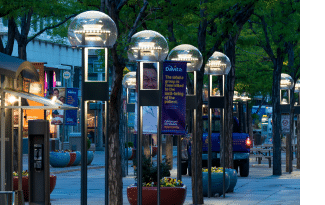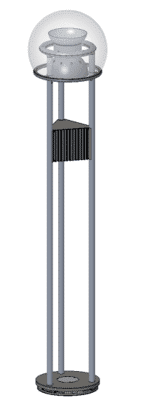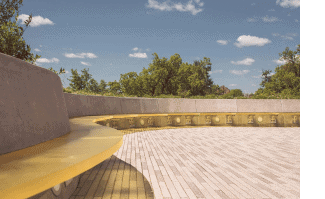Landscape Forms Improves Productivity by Designing Outdoor Lighting and Furniture with SOLIDWORKS
 Landscape Forms designs and builds beautiful site furniture and lighting, primarily for public spaces and college, corporate and healthcare campuses. In the early 2000s, Landscape Forms switched from 2D design tools to SOLIDWORKS design software and over the decade shortened design cycle time by 30 percent and reduced time-to-market by 15 to 20 percent.
Landscape Forms designs and builds beautiful site furniture and lighting, primarily for public spaces and college, corporate and healthcare campuses. In the early 2000s, Landscape Forms switched from 2D design tools to SOLIDWORKS design software and over the decade shortened design cycle time by 30 percent and reduced time-to-market by 15 to 20 percent.
Landscape Forms has also leveraged SOLIDWORKS to bring its optical and electrical design in-house and enhanced its ability to design organically shaped concrete site furniture and the tooling needed to build it. Fisher Unitech has provided training to upgrade user skills and responded quickly with expert technical support. “The result is that since 2011, Landscape Forms has reduced lighting design cycles by an additional 30 to 35 percent and time-to-market by 15 to 20 percent while reducing furniture design cycles by an additional 30 percent and time-to-market by 20 to 25 percent,” said Todd Halstead, CAD Team Leader for Landscape Forms.
Bringing Lighting Designs In-House
Landscape Forms believes the goal of outdoor lighting is not just to turn night into day but to provide effective, appropriate and beautiful lighting that delivers a great visual experience. For example, the company designed an LED lighting system for Denver’s 16th Street Mall that replicates the original iconic Howard Brandston luminaire design with 21st century technology. The design illuminates the pedestrian walkway with light of comfortable intensity, in color that properly renders skin and clothing, and incorporates a “twinkle ring” of small lights encircling the pole that casts light sideways to illuminate the fronts of stores and restaurants.
 Many outdoor spaces are over illuminated, with negative consequences for energy consumption, carbon emissions, human wellbeing and light pollution. While most people correctly associate light pollution as the brightening of the night sky, it may also be the presence of excessive or inappropriate light where it is not intended or needed. Landscape Forms LED lighting protects “Dark Sky” by delivering the appropriate light levels required for function and safety while avoiding over-illumination and its negative impacts on energy consumption and light spill. A number of Landscape Forms luminaires have received the Dark Sky Approved fixture seal of approval from the International Dark-Sky Association.
Many outdoor spaces are over illuminated, with negative consequences for energy consumption, carbon emissions, human wellbeing and light pollution. While most people correctly associate light pollution as the brightening of the night sky, it may also be the presence of excessive or inappropriate light where it is not intended or needed. Landscape Forms LED lighting protects “Dark Sky” by delivering the appropriate light levels required for function and safety while avoiding over-illumination and its negative impacts on energy consumption and light spill. A number of Landscape Forms luminaires have received the Dark Sky Approved fixture seal of approval from the International Dark-Sky Association.
In the past, Landscape Forms used outside contractors to design lighting optical and electrical systems. The company brought design in-house, using a SOLIDWORKS add-in called Photopia from LTI Optics to predict the direction and intensity of the lighting provided by a proposed design. Landscape Forms engineers also use SOLIDWORKS Flow Simulation to design, test and optimize lighting enclosures with sufficient airflow to maintain the electronic components at safe operating
temperatures.
“Integrating the lighting with the structural elements of the design in the SOLIDWORKS environment keeps the entire design team on the same page and makes it easy to produce renderings that provide a realistic depiction of how a proposed lighting system will transform its environment,” said Brandon Renouf, Lighting Innovation Specialist. The only part of the design done outside SOLIDWORKS is the printed circuit board, and here Landscape Forms uses software that exports a STEP file that can easily be imported into SOLIDWORKS.
Having the design, mechanical and optical teams all working in the same SOLIDWORKS environment makes it possible for all disciplines to work simultaneously rather than waiting for each other to complete a phase. The net result is that the project team can try out more ideas in a fraction of a second while working towards the final design.
Designing and Building Free-Form Site Furniture
The company’s site furniture business has also evolved. One of the changes is the addition of high-performance concrete that has increased the use of organic shapes to provide unique, artistic and functional properties. Landscape Forms engineers use SOLIDWORKS to design both the unique concrete shapes and the mechanically complex tooling used to produce them.
 Most of Landscape Forms concrete designs are built in a rotisserie mold – named because the mold rotates likes a rotisserie with each section of the structure being poured individually while it is in the bottom position of the mold. Each section of the mold is typically built from carbon fiber sheets to save weight. “Landscape Forms engineers use SOLIDWORKS Simulation to ensure that the mold itself is strong enough to support parts such as a 500-pound concrete bench,” said Halstead. Engineers also use SOLIDWORKS Simulation to design the mechanisms used to rotate the mold and to determine the best angle of rotation to fill each section of the mold.
Most of Landscape Forms concrete designs are built in a rotisserie mold – named because the mold rotates likes a rotisserie with each section of the structure being poured individually while it is in the bottom position of the mold. Each section of the mold is typically built from carbon fiber sheets to save weight. “Landscape Forms engineers use SOLIDWORKS Simulation to ensure that the mold itself is strong enough to support parts such as a 500-pound concrete bench,” said Halstead. Engineers also use SOLIDWORKS Simulation to design the mechanisms used to rotate the mold and to determine the best angle of rotation to fill each section of the mold.
Landscape Forms sells its products around the world, so it must comply with a wide range of buyer tastes and preferences, safety codes, environmental considerations, import rules, and other global market requirements. The company uses SOLIDWORKS Product Data Management to track multiple versions of its products. When the base version changes, SOLIDWORKS PDM highlights which versions are dependent on it and need to be updated to reflect the changes.
Training and Technical Support Provided by Fisher Unitech
 Landscape Forms uses Fisher Unitech as its sole provider of training and technical support. “Whenever we hire a new user, we schedule them for SOLIDWORKS training,” Halstead said. SOLIDWORKS online classes are taught by live instructors and are lecture-based so they provide an interactive approach not found in traditional online classes. While regular live classes require students to stay away from work for a week, Fisher Unitech online classes only take a few hours a day.
Landscape Forms uses Fisher Unitech as its sole provider of training and technical support. “Whenever we hire a new user, we schedule them for SOLIDWORKS training,” Halstead said. SOLIDWORKS online classes are taught by live instructors and are lecture-based so they provide an interactive approach not found in traditional online classes. While regular live classes require students to stay away from work for a week, Fisher Unitech online classes only take a few hours a day.
When Landscape Forms SOLIDWORKS users need technical support, they go to the customer section of Fisher Unitech’s website and enter information that defines the type of issue they are facing. A Fisher Unitech technical support engineer with expertise in this particular issue calls them back in 30 minutes or less. Landscape Forms has used Fisher Unitech technical support long enough that they have established personal relationships with many Fisher Unitech support representatives which allows them to directly call the support representative that they know can resolve their issue.
“Maintaining our current pace of growth has required upgrading the skills of our technical team, getting each of the disciplines involved in the design process on the same page, and accelerating our use of simulation to get the design right the first time,” Halstead concluded. “The training and technical support provided by Fisher Unitech has helped us take full advantage of the capabilities of SOLIDWORKS to make it happen.”
Related Articles
SOLIDWORKS Concept to Consumer Tour: Coming to a City Near You
SOLIDWORKS Flow Simulation Tutorial: Fluid Flow Problems
Comparing SOLIDWORKS Packages: Standard vs Professional or Premium
3D Printing for Optical Interactivity: Disney & Stratasys
About the Author
 Christa Prokos is a marketing manager at Fisher Unitech. She researches and writes about the latest business trends and technologies impacting manufacturers, including 3D printing, SOLIDWORKS 3D CAD design and product data management tools, product lifecycle management, virtual reality, and the Internet of Things. Christa has worked as a high tech marketing and communications professional since 2000.
Christa Prokos is a marketing manager at Fisher Unitech. She researches and writes about the latest business trends and technologies impacting manufacturers, including 3D printing, SOLIDWORKS 3D CAD design and product data management tools, product lifecycle management, virtual reality, and the Internet of Things. Christa has worked as a high tech marketing and communications professional since 2000.

 Blog
Blog